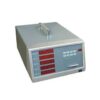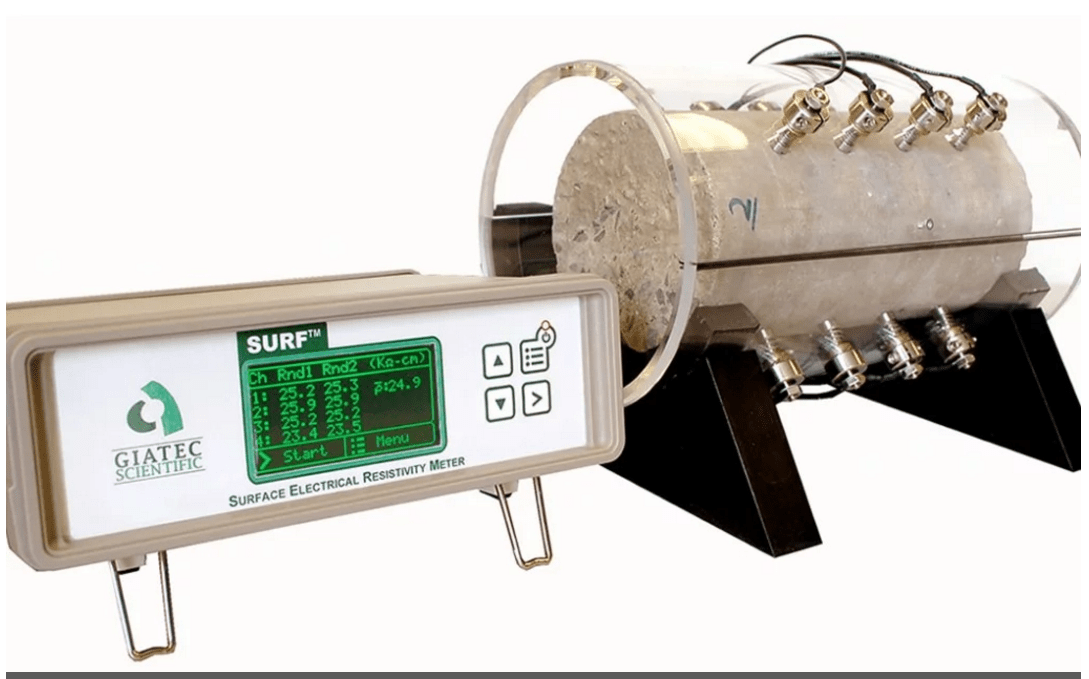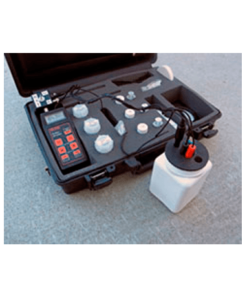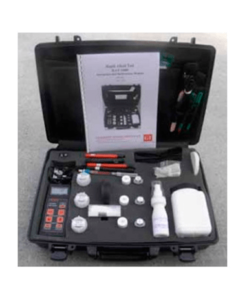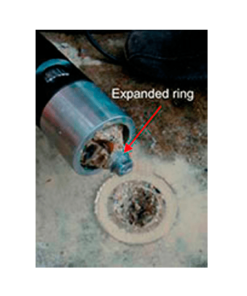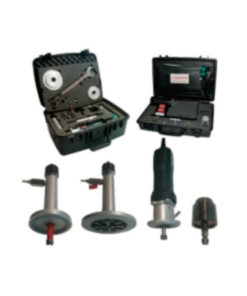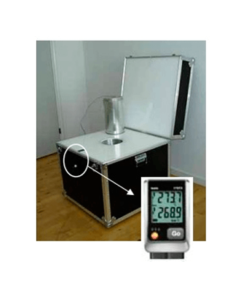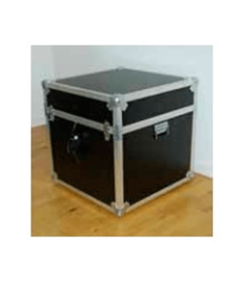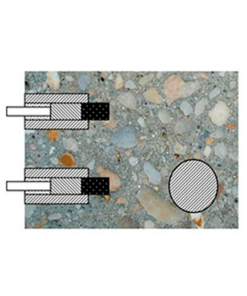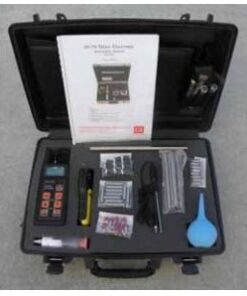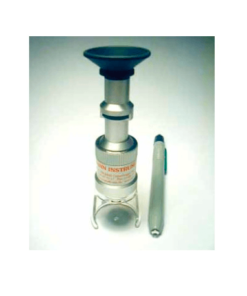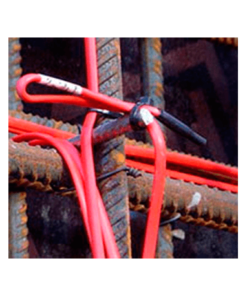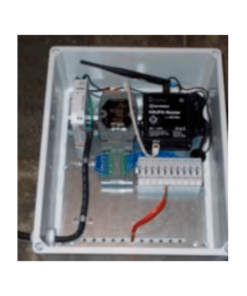Surf™ | Resistividad del hormigón en su superficie
Giatec Surf ™ es un dispositivo de prueba de laboratorio para la medición rápida, fácil y precisa de la resistividad eléctrica superficial del hormigón basada en la técnica de cuatro sondas (Wenner-Array). La tecnología patentada Surf ™ mide automáticamente la resistividad alrededor de la muestra de hormigón usando cuatro canales de matriz de 4 sondas (situados a 90 ° entre sí). El software PC genera los informes requeridos de acuerdo con las especificaciones estándar.
Surf ™ se puede utilizar para determinar la permeabilidad al cloruro del hormigón de acuerdo con AASHTO TP95 y la próxima norma ASTM. Los datos de medición se pueden utilizar para el control de calidad basado en la durabilidad del hormigón, así como el diseño de la vida útil de las estructuras de hormigón.
Solicitud de CotizaciónDescargas:
La resistividad eléctrica del hormigón se correlaciona bien con parámetros importantes de durabilidad como permeabilidad, difusividad y, en general, las características de la microestructura del hormigón. Es un método rápido y fácil de control de calidad durante la nueva construcción.
Surf ™ es un dispositivo único para la medición de resistividad automática de 4 canales adecuada para investigar las propiedades microestructurales del hormigón, incluyendo:
- Control de calidad basado en la durabilidad del hormigón
- Difusión de cloruro en hormigón
- Tiempo de fraguado del hormigón fresco
- Detección de grietas en hormigón
- Contenido de agua en hormigón fresco
- Tecnología patentada
- El único dispositivo en el mercado totalmente compatible con el AASHTO T95 y el próximo estándar ASTM
- Fácil de usar (ver demo en YouTube)
- Frecuencia variable (13 – 100 Hz)
- Amplio rango de resistividad (0.1 – 1,000 kΩ.cm)
- Rápida medición (8 mediciones < 15s)
- Medición de cuatro sondeos de cuatro canales
- Limitación de la pérdida de humedad
- Generación automática de informes con software de PC
- Pruebas de hormigón fresco / detección de grietas
- Modo de medición continua
- Conexión USB a la computadora
AASHTO TP 95-11 proporciona la prueba estándar para la medición de resistividad eléctrica superficial. También se está desarrollando un estándar ASTM para esta prueba. Se puede obtener aquí una copia de la especificación de prueba AASHTO titulada “Método estándar de ensayo para la indicación de resistividad superficial de la capacidad del hormigón para resistir la penetración de iones de cloruro”.General
| Rango de Lectura | Rango de Frecuencia | Precisión |
| 0.1 – 100 KΩ.cm | 13 – 100 Hz | ± (0.1+1%) |
| 100 – 1000 KΩ.cm | 13 – 100 Hz | ± (1+1%) |
Tiempo de Medición
| Frecuencia | Tiempo de Medición Simple | Tiempo de Prueba (8 mediciones) |
| 13 – 100 Hz | 1.5 segundos | <15 segundos |
Condiciones de operación
| Tipo | Valor |
| Temperatura de operación | 15 ~ 45 °C |
| Humedad | 30 ~ 80% |
| Temperatura de almacenamiento | 0 ~ 60°C |
| Tensión / corriente de funcionamiento | 100-250 V ± 10%, 60Hz |
| Dimensiones de Surf ™ | 200 x 160 x 70 mm |
| Part No. | Item | Descripción |
| 900107 | Surf™ – Comprehensive Package | Unidad Surf ™, 100×200 mm (4 “x 8”) Soporte de muestra, Adaptador de corriente, Cable USB, PC Software, Manual de usuario, Gel conductivo, Kit de verificación, Juego adicional de pastillas conductoras, |
| 900037 | Surf™ – D100 Full Package | Unidad Surf ™, 100×200 mm (4 “x 8”) Porta muestras, Adaptador de corriente, Cable USB, Software, Manual del usuario, Gel conductivo, Kit de verificación, Juego adicional de almohadillas conductoras |
| 900030 | Surf™ Device | Unidad Surf ™, Adaptador de corriente, Cable USB, Software, Manual de usuario, Kit de verificación |
Las siguientes piezas de repuesto y accesorios están disponibles por encargo:
| Part No. | Item | Descripción |
| 900100 | Sonda de mano | Para la medición de la resistividad eléctrica superficial sobre superficies planas de grandes muestras / elementos de hormigón |
| 900031 | Soporte de muestras de superficie-D100 | Tamaño de la muestra 100×200 mm (4 “x 8”), gel conductor, conjunto adicional de almohadillas conductoras |
| 900032 | Kit de verificación | Dongles de gama alta y baja para verificar el rendimiento del dispositivo |
| 900038 | Gel Conductivo – Alta Viscosidad | Botella de 250 ml |
| 900033 | Cable de prueba | Cable de conexión de cuatro puntos con clip de cocodrilo |
| 900034 | Juego de esponjas de contacto | 16 piezas |
P1: ¿Se requiere usar esponjas húmedas para medir la resistividad usando Surf ™?
R: Si está probando especímenes secos de superficie saturada (condición SSD), no hay necesidad de usar esponjas húmedas. Pero, para los especímenes secos, usted tiene que usar esponjas húmedas en las puntas de conexión o el gel conductor proporcionado con el dispositivo.
P2: ¿Cómo toma Surf ™ mediciones más rápido?
R: Giatec Surf ™ utiliza una tecnología patentada para medir automáticamente la resistividad superficial 8 veces alrededor del espécimen de concreto cilíndrico usando sus cuatro canales de matrices de 4 sondas. El software de PC genera los informes requeridos de acuerdo con las especificaciones estándar.
P3: ¿Se puede utilizar Surf ™ para pruebas de campo en hormigón endurecido, o sólo para uso en laboratorio?
R: La versión actual de Surf ™ ha sido diseñada para aplicaciones de laboratorio en el control de calidad basado en la durabilidad del hormigón. Un accesorio que está en desarrollo para Surf ™ permite a este dispositivo aplicaciones de campo.
P4: ¿Cómo puedo usar Surf ™ para otras aplicaciones?
R: Los cuatro canales de entrada del dispositivo Surf ™ se pueden conectar a los cables accesorios para personalizar la configuración de prueba para la medición de resistividad superficial de la superficie de elementos de hormigón (por ejemplo, detección de fisuras bajo carga) o incrustarse en hormigón fresco y endurecido para monitorizar el ajuste Y el transporte de humedad, respectivamente. El equipo científico de Giatec estará encantado de ayudarle con su solicitud de proyecto de investigación en particular.
- Hammond, E., & Robson, T. D. (1955). Comparison of Electrical Properties of Various Cements and Concretes. The Engineer (London), 199(5165) 78-80, and 199(5166), 114-115.
- Nikkanen, P. (1962). On the Electrical Properties of Concrete and Their Applications. Vaftion Tebsilliren Tutkirndaitos, Tiedotus, Sarja III, Rakennus 60, 75 pages. In Finnish with English summary.
- Henry, R. L. (1964). Water Vapor Transmission and Electrical Resistivity of Concrete. Final Report. U. S. Naval Civil Engineering Laboratory, Port Hueneme, California, Technical Report,R-314, 39 pages.
- Tobio, J. M. (1959). A Study of the Setting Process, Dielectric Behavior of Several Spanish Cements. Silicates Zrrdrcsb-iek, 24, 30-35 and 81-87.
- Power, T. C. (1958). Structure and Physical Properties of Hardened Portland Cement Paste. Journal of the American Ceramic Society, 41(1), 1-6; PCA Research Department, Bulletin 94.
- Jones, G., & Christian, S. M. (1935). The Measurement of the Conductance of Electrolytes. VI. Galvanic Polarization by Alternating Current. Journal of the American Chemical Society, 57, 272-280.
- Terry, E. M. (1929). ADVANCED LABORATORY PRACTICE IN ELECTRICITY AND MAGNETISM, 2nd Edition, McGraw-Hill, N.Y., 197.
- Fricke, H. (1931). The Electric Conductivity and Capacity of Disperse Systems. Physics, 1(2), 106-115.
- Frcitag, F. E. (1959). (Dyckerhoff and Widmann Kommanditgesellschaf t). Increasing the Electrical Resistance and Strength of Concrete. German Patent No. 1,064,863. In German. See abstract in English in Chemical Abstracts, 55(8), 7798d.
- Budnikov, P. P., & Strelkov, M.I. (1966). Some Recent Concepts on Portland Cement Hydration and Hardening. SYMPOSIUM ON STRUCTURE OF PORTI.AND CEMENT PASTE AND CONCRETE, Highway Research Board Special Report 90, Table 3, 450.
- Seligmann, P. (1968). Nuclear Magnetic Resonance Studies of the Water in Hardened Cement Paste. Journal of the PCA Research and Development Laboratories, 10(1), 52-65; PCA Research Department Bulletin 222.
- Monfore, G. E., & Verbeck, G. J. (1960). Corrosion of Prestressed Wire in Concrete. Journal of the American Concrete Institute; Proceedings, 57, 491-515; PCA Research Department Bulletin 120.
- Monfore, G. E., & Ost, B. (1965). Corrosion of Aluminum Conduit in Concrete. Journal of the PCA Research and Development Laboratories, 7(1), 10-22; PCA Research Department Bulletin 173.
- Andrade, C. (2010). Types of Models of Service Life of Reinforcement: The Case of the Resistivity. Concrete Research Letters, 1(2), 73- 80.
- Bertolini, L., & Polder, R. B. (1997). Concrete Resistivity and Reinforcement Corrosion Rate as a Function of Temperature and Humidity of the Environment. TNO report 97-BT-R0574, Netherland.
- Bryant, J. W., Weyers, R. E., & Garza, J. M. (2009). In-Place Resistivity of Bridge Deck Concrete Mixtures. ACI Materials Journal, 106(2), 114-122.
- Buehlef, M. G. & Thurber, W. R. (1976). A Planar Four-Probe Structure for Measuring Bulk Resistivity. IEEE Transactions on Electron Devices, 23(8), 968-974.
- Butefuhr, M., Fischer, C., Gehlen, C., Menzel, K., & Nurnberger, U. (2006). On-Site Investigation on Concrete Resistivity a Parameter of Durability Calculation of Reinforced Concrete Structures. Materials and Corrosion, 57(12), 932-939.
- Chatterji, S. (2005). A Discussion of the Papers, ”A Novel Method for Describing Chloride Ion Transport due to an Electrical Gradient in Concrete: Part 1 and Part 2” by K. Stanish, R.D. Hooton, M.D.A. Thomas. Cement and Concrete Research, 35(9), 1865-1867.
- Chini, A. R., Muszynski, L. C., & Hicks J. (2003). Determination of Acceptance Permeability Characteristics for Performance-Related Specifications for Portland Cement Concrete. Final report submitted to FDOT (MASc. Thesis), University of Florida, Department of Civil Engineering.
- Edvardsen
- Elkey, W. & Sellevold E. J. (1995). Electrical Resistivity of Concrete. Published Report, No. 80, Norwegian Road Research Laboratory, Oslo, Norway, 36 pages.
- Ewins, A. J. (1990). Resistivity Measurements in Concrete. British Journal of NDT, 32(3), 120-126.
- Feliu, S., Andrade, C., Gonzalez, J. A., & Alonso, C. (1996). A New Method for In-situ Measurement of Electrical Resistivity of Reinforced Concrete. Materials and Structures, 29(6), 362-365.
- Ferreira, R. M., & Jalali, S. (2010). NDT Measurements for the Prediction of 28-day Compressive Strength. NDT & E International, 43(2), 55-61.
- Florida DOT FM 5-578. (2004). Method of Test for Concrete Resistivity as an Electrical Indicator of Its Permeability, 226.
- Forster, S.W. (2000). Concrete Durability-Influencing Factors and Testing. Farmington Hills, MI. Durability of Concrete, ACI Committee, Vol. 191, 1-10.
- Gowers, K. R. & Millard, S. G. (1999). Measurement of Concrete Resistivity for Assessment of Corrosion Severity of Steel Using Wenner Technique. ACI Material Journal, 96(5), 536-541.
- Hansson, I. L. H. & Hansson, C. M. (1953). Electrical Resistivity Measurements of Portland Cement Based Materials. Cement and Concrete Research, 13(5), 675-683.
- Hooton, R.D., Thomas, M.D.A., & Stanish, K., (2001). Prediction of Chloride Penetration in Concrete. Federal Highway Administration, Report No. FHWA-RD-00-142.
- Ishida, T., & Li, C. H. (2008). Modeling of Carbonation Based on Thermo-Hygro Physics with Strong Coupling of Mass Transport and Equilibrium in Micro-pore Structure of Concrete. Retrieved from http://www.jsce.or.jp/committee/concrete/e/newsletter/newsletter14/isida.pdf
- Jianyong, L., & Pei, T. (1997). Effect of Slag and Silica Fume on Mechanical Properties of High Strength Concrete. Cement and Concrete Research, 27(6), 833-837.
- Kosmatka, S. H., Kerkhoff, B., Panarese, W. C., MacLeod, N. F., &McGrath, R. J. (2002). Design and Control of Concrete Mixtures, Seventh Canadian Edition. Cement Association of Canada, 227.
- Kessler, R. J., Power, R. G., & Paredes, M. A. (2005). Resistivity Measurements of Water Saturated Concrete as an Indicator of Permeability. Corrosion 2005, Houston, TX, 1-10.
- Kessler
- Lataste, J. F., Sirieix, C., Breysse, D., & Frappa M. (2003). Electrical resistivity measurement applied to cracking assessment on reinforced concrete structures in civil engineering. NDT & E International, 36(6), 383-394.
- Lopez, W., & Gonzalez, J. A. (1993). Influence of the Degree of Pore Saturation on the Resistivity of Concrete and the Corrosion Rate of Steel Reinforcement. Cement and Concrete Research, 23(2), 368-376.
- McCarter, W. J., Starrs, G., Kandasami, S., Jones, R., & Chrisp, M. (2009). Electrode Configuration for Resistivity Measurements on Concrete. ACI Materials Journal, 106(3), 258-264.
- Millard, S. G., Harrison, J. A., & Edwards, A. J. (1989). Measurements of the Electrical Resistivity of Reinforced Concrete Structures for the Assessment of Corrosion Risk. British Journal of NDT, 13(11), 617-621.
- Millard, S. G. & Gowers, K. R. (1991). The Influence of Surface Layers upon the Measurement of Concrete Resistivity. Durability of Concrete, Second International Conference, ACI SP-126, Montreal, Canada, 1197-1220, 228.
- Monfore, G. E. (1968). The Electrical Resistivity of Concrete. Journal of the PCA Research Development Laboratories, 10(2), 35-48.
- Monkman, S. & Shao, Y. (2006). Assessing the Carbonation Behaviour of Cementitious Materials. Journal of Materials in Civil Engineering, 18(6), 768-776.
- Morris, W., Moreno, E. I., & Sagues, A. A. (1996). Practical Evaluation of Resistivity of Concrete in Test Cylinders Using A Wenner Array Probe. Cement and Concrete Research, 26(12), 1779-1787.
- Newlands, M. D., Jones, M. R., Kandasami, S., & Harrison T. A. (2008). Sensitivity of Electrodes Contact Solutions and Contact Pressure in Assessing Electrical Resistivity of Concrete. Materials and Structures, 41(4), 621-632.
- Nokken, M. R. & Hooton, R. D. (2006). Electrical Conductivity as a Prequalification and Quality Control. Concrete International, 28(10), 61-66.
- Parrott, L. J. (1994). Moisture Conditioning and Transport Properties of Concrete Test Specimens. Materials and Structures, 27(8), 460-468.
- Polder, R. B. (2001). Test Methods for on Site Measurement of Resistivity of Concrete – a RILEM TC-154 Technical Recommendation. Construction and Building Materials, (15)2-3, 125-131, 229.
- Pun, P., Kojuncdic, T., Hooton, R.D., Kojundic, T., & Fidjestol P. (1997). Influence of Silica Fume on Chloride Resistance of Concrete. Proceedings of PCI/FHWA International Symposium on High Performance Concrete, New Orleans, Louisiana, 245–256.
- RILEM Technical Committee. (2005). Update of the Recommendation of RILEM TC 189-NEC Non-destructive Evaluation of the Concrete Cover (Comparative Test Part I, Comparative Test of Penetrability Methods). Materials & Structures, 38(284), 895-906.
- Savas B. Z. (1999). Effect of Microstructure on Durability of Concrete (PhD Thesis). North Carolina State University, Department of Civil Engineering, Raleigh NC.
- Sengul, O. & Gjorv, O. E. (2008). Electrical Resistivity Measurements for Quality Control During Concrete Construction. ACI Materials Journal, 105(6), 541-547.
- Sengul, O. & Gjorv, O. E. (2009). Effect of Embedded steel on Electrical Resistivity Measurements on Concrete Structures. ACI Materials Journal, 106(1), 11-18.
- Scrivener, K. L., Crumbie, A. K., & Laugesen P. (2004). The Interfacial Transition Zone (ITZ) Between Cement Paste and Aggregate in Concrete. Interface Science, 12(4), 411- 421, 230.
- Shi, C. (2004). Effect of Mixing Proportions of Concrete on its Electrical Conductivity and the Rapid Chloride Permeability Test (ASTM C1202 or ASSHTO T277) Results. Cement and Concrete Research, 34(3), 537-545.
- Smith, K. M., Schokker, A. J., & Tikalsky P. J. (2004). Performance of Supplementary Cementitious Materials in Concrete Resistivity and Corrosion Monitoring Evaluations. ACI Materials Journal, 101(5), 385-390.
- Stanish, K., Hooton, R. D., & Thomas, M. D. A. (1997). Testing the Chloride Penetration Resistance of Concrete: A Literature Review. Department of Civil Engineering University of Toronto, Ontario, Canada. FHWA Contract DTFH61-97-R 00022. Prediction of Chloride Penetration in Concrete.
- Stanish, K., Hooton, R. D., & Thomas, M. D. A. (2004). A Novel Method for Describing Chloride Ion Transport due to an Electrical Gradient in Concrete: Part 1. Theoretical description. Cement and Concrete Research, 34(1), 43-49.
- Stanish, K., Hooton, R. D., & Thomas M. D. A. (2004). A Novel Method for Describing Chloride Ion Transport due to an Electrical Gradient in Concrete: Part 2. Experimental study. Cement and Concrete Research, 34(1), 51-57.
|
|
C. (2002). Chloride Migration Coefficients from Non-Steady-State Migration Experiments at Environment-Friendly “Green” Concrete. Retrieved from www.gronbeton.dk/artikler/Chloride migration coefficients.pdf. |
|
|
R. J. | Power | R. G. | Vivas | E. | Paredes | M. A. | & Virmani | Y.P. (2008). Surface | Resistivity as an Indicator of Concrete Chloride Penetration Resistance. Retrieved from http://concreteresistivity.com/Surface Resistivity.pdf |

